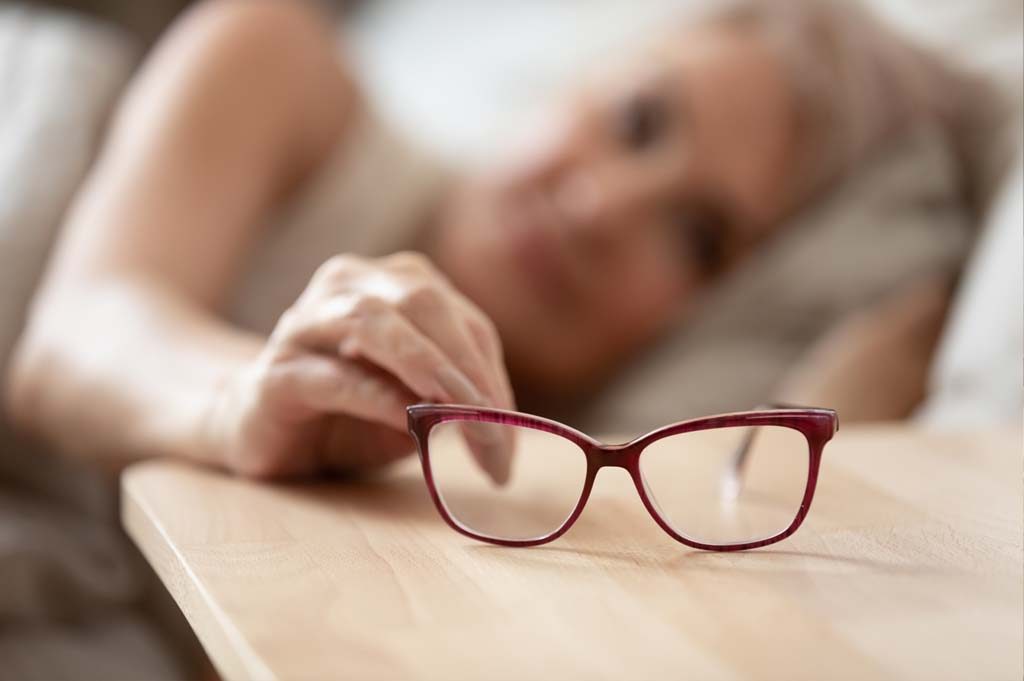
Presbyopia
In your 40s, you might have to remove your glasses or contacts to see close up, or you might need reading glasses. This is presbyopia and is normal for ageing eyes. Blurred near vision when reading and working at the computer is a common symptom. Correction typically includes eyeglasses or contact lenses with bifocal, trifocal or progressive lenses.
Vitreous detachment
When tiny pieces of the eye’s gel-like substance break loose in the rear of the eye, spots known as floaters typically appear or “float” across our field of vision. These are usually harmless, but a rapid or sudden onset of floaters with flashes of light could be signs of a detached retina – seek immediate medical attention.
Reduced pupil size and reactivity
With less eye muscle strength, older eyes may struggle to react and adapt to light, like when reading or exiting a dimly lit movie theatre. Add more light when needed, and ask about photochromic lenses and anti-reflective coatings so your eye scan adjust comfortably.
Dry eyes
Over-the-counter artificial tears and prescription medications can soothe the burning, stinging and dryness caused by decreased tear production. Besides age, one major risk factor is computer work, which reduces blink rate.
Declining peripheral vision
A shrinking visual field increases the risk of automobile accidents. Be extra careful when driving, especially at inter sections where seeing what’s on the periphery is critical.
Age-related Macular Degeneration (AMD)
One of the leading causes of blindness among seniors, this painless disease destroys the macula, resulting in blurred central vision and a disrupted ability to see detail, colour, and even recognise faces. There are two forms of the disease: wet and dry. Treatment of wet AMD includes anti-VEGF drugs injected into the eye, laser procedure, photodynamic therapy and lifestyle changes. Certain supplements may slow the progression of intermediate stage of wet AMD by 25%.
Diabetic Retinopathy
This is the most common diabetic eye disease, and results from progressive damage to the tiny blood vessels of the retina. If new blood vessels grow, they can bleed into the eye and block vision. It is estimated that 40% of diagnosed diabetics have some degree of retinopathy.
Cataract
90% of people in their 70s have some degree of cataract. Blurriness and cloudiness are common, resulting from clumping of naturally occurring protein within the lens of the eye. While cataracts can lead to blindness or glaucoma if left untreated, bladeless cataract surgery is extremely safe, has an immense success rate, and is the most frequently performed surgery. Vision can be restored by replacing the clouded lens with a man-made intraocular lens (IOL).
Glaucoma
This ‘silent thief of sight’ rarely exhibits symptoms until damage is done. In the eyeball, a fluid called aqueous humour is constantly produced and drained. Glaucoma develops when there is excessive build up of that fluid which creates pressure in the eye. It causes 40% of blindness cases in Singapore, yet many more people may be living with it. The only way to control it is with treatment. Damage to the eye is irreversible, but if detected early, medical treatment or surgery can prevent vision loss.
Eye care for over-40s
Play an active role in helping prevention with these practices:
- Eat healthy. Nutrients like lutein and zeaxanthin, zinc, and antioxidants in vitamins A, C and E can help lower your AMD risk. Omega-3 fatty acids can also help.
- Don’t smoke. It increases risks of early onset AMD, diabetic retinopathy, hypertension and cataract formation.
- Protect your eyes from UV exposure by wearing sunglasses.
- Control weight, blood pressure and cholesterol levels. All are linked with AMD, glaucoma and diabetic retinopathy.
- Exercise. Studies suggest that exercise can reduce the risk of AMD by up to 70%. There is also a link between physical activity and glaucoma prevention.
- Sugar control by diabetics is essential to prevent ocular complications.
- Wear safety eyewear during sports and other activities that could harm your eyes. Serious eye injuries can lead to glaucoma.
- Seek immediate medical help if you notice any abrupt changes in your eyesight.







